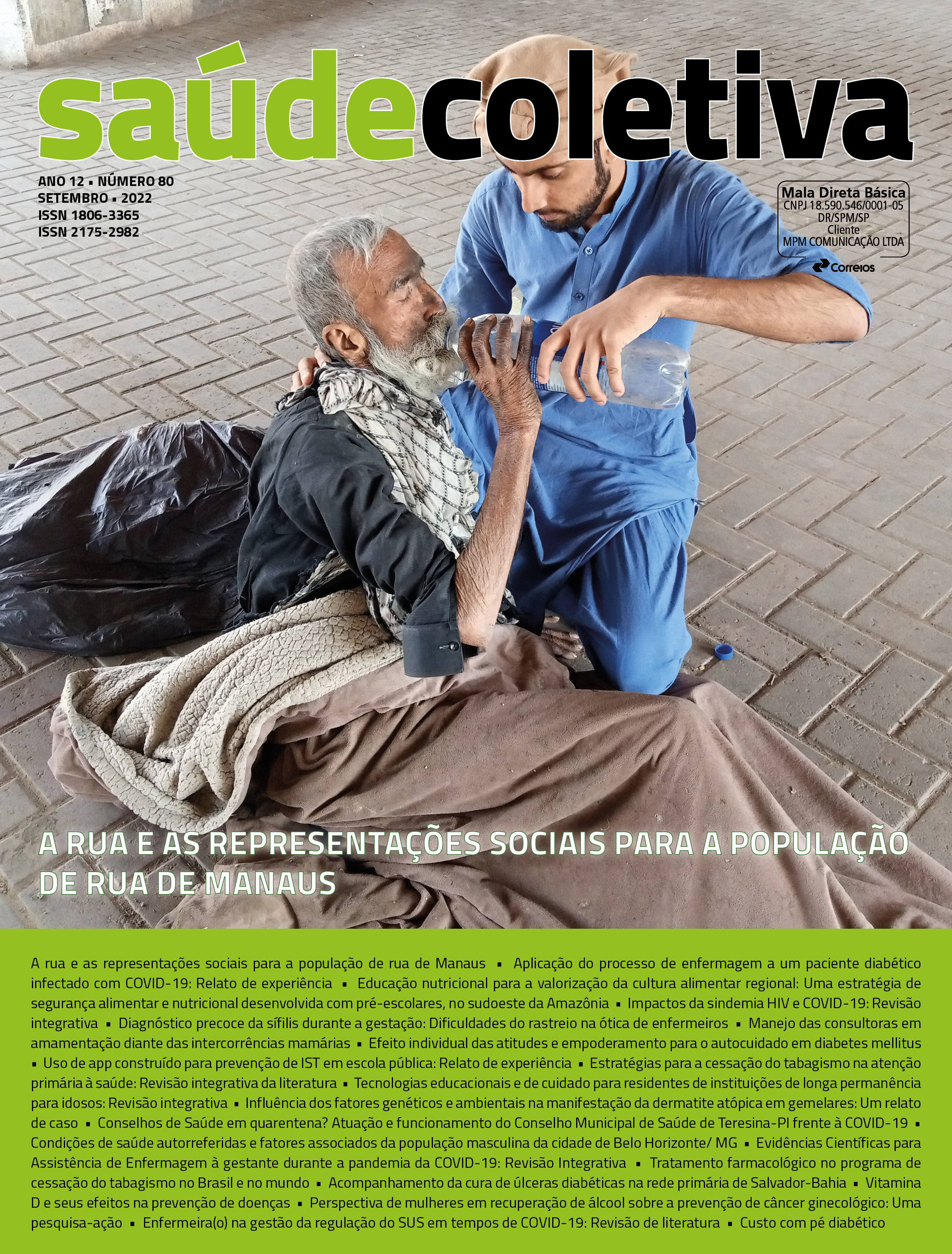The street and social representations for the population of street of Manaus
DOI:
https://doi.org/10.36489/saudecoletiva.2022v12i80p11228-11237Keywords:
Social representations, Homeless population, Qualitative researchAbstract
The work presents some meanings of the street from the point of view of the population that makes it their home, dealing with the different meanings it assumes for the subjects. Social representations result from information and collective actions carried out by small groups, and they reflect on defined attitudes. The research was carried out during the second wave of covid-19 with people who live on the streets in Manaus through conversation circles and artistic expression activities. As a result, it was possible to observe how the meaning of street follows a negative result in terms of health, food, housing, safety, comfort and sociability, with crime, fear and the lack of adequate food being the factors most correlated to the definition of what it's life on the street. The representation of the street is sometimes painful and sometimes a place of affection, the way the street is characterized in its complexity.
References
Alcântara SC, Abreu DP, Farias AA. Pessoas em situação de rua: das trajetórias de exclusão social aos processos emancipatórios de formação de consciência, identidade e sentimento de pertença. RCP, 2015. 129-143. v. 24.
Alles, N. L. Boca de Rua : representações sociais sobre população de rua em um jornal comunitário. 2010.
Araújo, MCRH. The social representations theory and the anthropological research. São Paulo, 2008, n. 2, p. 98-119.
Bardin, L. Análise de conteúdo. São Paulo: Edições 70, 2011. 118 p.
Brasil. Decreto Nº 7.053 DE 23 DE DEZEMBRO DE 2009. Institui a Política Nacional para a População em Situação de Rua e seu Comitê Intersetorial de Acompanhamento e Monitoramento, e dá outras providências. Diário Oficial da União. 2009 Dezembro. (1 Seção).
Paula HC de, Daher DV, Koopmans FF, Faria MGA, Lemos PFS, Moniz MA. RBE, 2020. No place to shelter: ethnography of the homeless population in the COVID-19 pandemic..; 73 (Suppl 2):e20200489. doi: http://dx.doi.org/10.1590/0034-7167-2020-0489
Ferreira, FV.; ALVES, MP. Representações sociais dos moradores de rua no jornal correio brasiliense: exclusão, dessemelhança e violência. RICA, 2015. Blumenau, v.9, n.3, p.35-56.
Freitas, C.J. et al. Morar na rua na pandemia é possível? RPP&C, 2021 v. 2, 04 maio.
Gatinho, EJ et al, Quadros,O olhar invisível: visões e narrativas de populares em situação de rua e vulnerabilidade social nos tempos de pandemia da Covid-19 em Bragança-PA, 2020 – Volume. VIII - no 03.
Manaus - Informações sobre o município e a prefeitura. Disponível em: <https://www.cidade-brasil.com.br/municipio-manaus.html>. Acesso em: 7 nov. 2021.
Mattos, RM.; FERREIRA, R.F. Quem vocês pensam que (elas) são? representações sobre as pessoas em situação de rua. 2004. P&S. v. 16, n. 2, p. 47-58.
Montes, ML. “Essas pessoas a quem chamamos população de rua”. In. Cadernos do CEAS, 1994 Salvador, Bahia. n.151: pp. 35-41.
Moscovici, Serge. Representações sociais: investigações em psicologia social. 5ª ed. Petrópolis, RJ: Vozes, 2007. 397 p.
Oliveira, FJ.; FEITOSA, M Z. DE S. Representações Sociais e População Em Situação De Rua: A Visibilidade Construída Pela. RFSA, 2016, v. 13, n. 2, p. 226–243, 24.
Palheta, R; TARGINO, R. e LIMA, J. (Sobre) vivencias nas ruas de Manaus: historias, condições de vida e políticas de saúde. Curitiba. Ed CRV, 2019.
Resende, VM.; MENDONÇA, D. G. DE. População em situação de rua e políticas públicas: representações na Folha de São Paulo. DELTA: Documentação de Estudos em Lingüística Teórica e Aplicada, v. 35, 2 dez.
Sicari, A A.; ZANELLA, AV. Pessoas em Situação de Rua no Brasil: Revisão Sistemática. PCeP, 2018. v. 38, p. 662–679.
Silva, I. C. N. et al. Representações sociais do cuidado em saúde de pessoas em situação de rua. REE, 2018, v. 52, 24.
Zandomingo, MN. P; Oliveira, JF; Silva, DO; Porcino, C; Suto, CSS; Oliveira, DS. Pobreza, fome e abandono: representações da equipe de enfermagem sobre pessoas em situação de rua, 2020. RBEN, v. 73.







